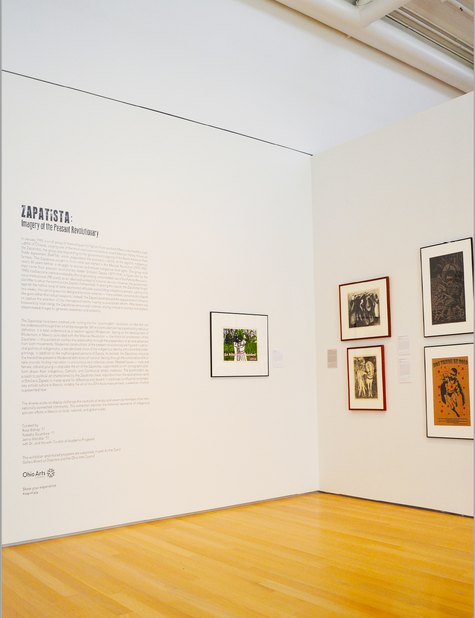Zapatista: Imagery of the
Peasant Revolutionary

Student-curated show at the Gund Gallery examining the thematic and iconographic connections between protest material inspired by the Zapatista revolutionaries of the 1990s and works produced by early 20th century Mexican masters, such as Diego Rivera and José Clemente Orozco.
On view April 24 – July 9 2017 at the Gund Gallery, Kenyon College.
In January 1994, a small group of masked guerrilla fighters from southern Mexico stormed the state capital of Chiapas, staging one of the most explosive moments in recent Mexican history. Known as the Zapatistas, the group was responding to the government’s signing of the North American Free Trade Agreement (NAFTA), which jeopardized the economic viability of the region’s indigenous farmers. The Zapatistas sought to finish what was started in the Mexican Revolution (1910-1920), nearly 80 years before: a struggle to recover and ensure indigenous land rights. The group took their name from peasant revolutionary leader Emiliano Zapata (1879-1919), a figure who by the 1990s had become institutionalized by the longstanding, uncontested rule of the Partido Revolucionario Institucional (PRI party) as an idealized symbol of national identity. However, the government did little to serve the communities Zapata championed. In seizing the capital, the Zapatistas fought against the hollow irony of state-sponsored attitudes surrounding indigenous people. Lasting only two weeks, this uprising was not designed to incite violence — many soldiers carried sticks shaped like guns rather than actual weapons. Instead, the Zapatistas employed the appearance of militancy to capture the attention of the international media, hoping to precipitate reform. After peace was brokered by local clergy, the Zapatistas renounced violence, relying instead on printed and digitally disseminated images to generate awareness and solidarity.
The Zapatistas have been credited with inciting the first “postmodern” revolution, an idea that can be understood through their art and propaganda. While postmodernism has a particularly nebulous definition, it is best understood as a reaction against Modernism. Seeing as the development of Modernism in Mexico coincided with the Mexican Revolution — the historical predecessor of the Zapatistas — this exhibition clarifies this relationship through the presentation of art and ephemera from both movements. Modernist constructions of the peasant revolutionary are figured in patriarchal politics of indigenismo, a standardized vision of the indigenous identity with nationalist underpinnings, in addition to the mythologized persona of Zapata. In contrast, the Zapatistas renounce the hierarchies present in Modernist definitions of national identity through the combination of multiple sources, finding inspiration in anonymous and collective voices. Masked figures — male and female, old and young — populate the art of the Zapatistas, supported by a rich iconographic platform drawn from indigenous, Catholic, and Communist artistic traditions. The postmodern approach to political art championed by the Zapatistas takes inspiration from the revolutionary spirit of Emiliano Zapata to create space for difference and dissent. It continues to influence contemporary activist culture in Mexico, notably the art of the 2014 Ayotzinapa protests, a selection of which is presented here.
The diverse works on display challenge the neutrality of artists and viewers as members of an internationally-connected community. This exhibition explores the historical resonance of indigenous activism efforts in Mexico on local, national, and global scales.
Curated by:
Rose Bishop ’17
Natasha Siyumbwa ’17
Jenna Wendler ’17
The Gund Gallery exhibitions and programs are made possible, in part, by the Gund Gallery Board of Directors and the Ohio Arts Council.
http://www.thegundgallery.org/2017/03/zapatista-imagery-of-the-peasant-revolutionary/
Image: Diego M. Rivera, Zapata, 1932. Lithograph, 22 1/2 x 16 inches. Collection of the Kalamazoo Institute of Arts; Director's Fund Purchase, 1964/5.741




















